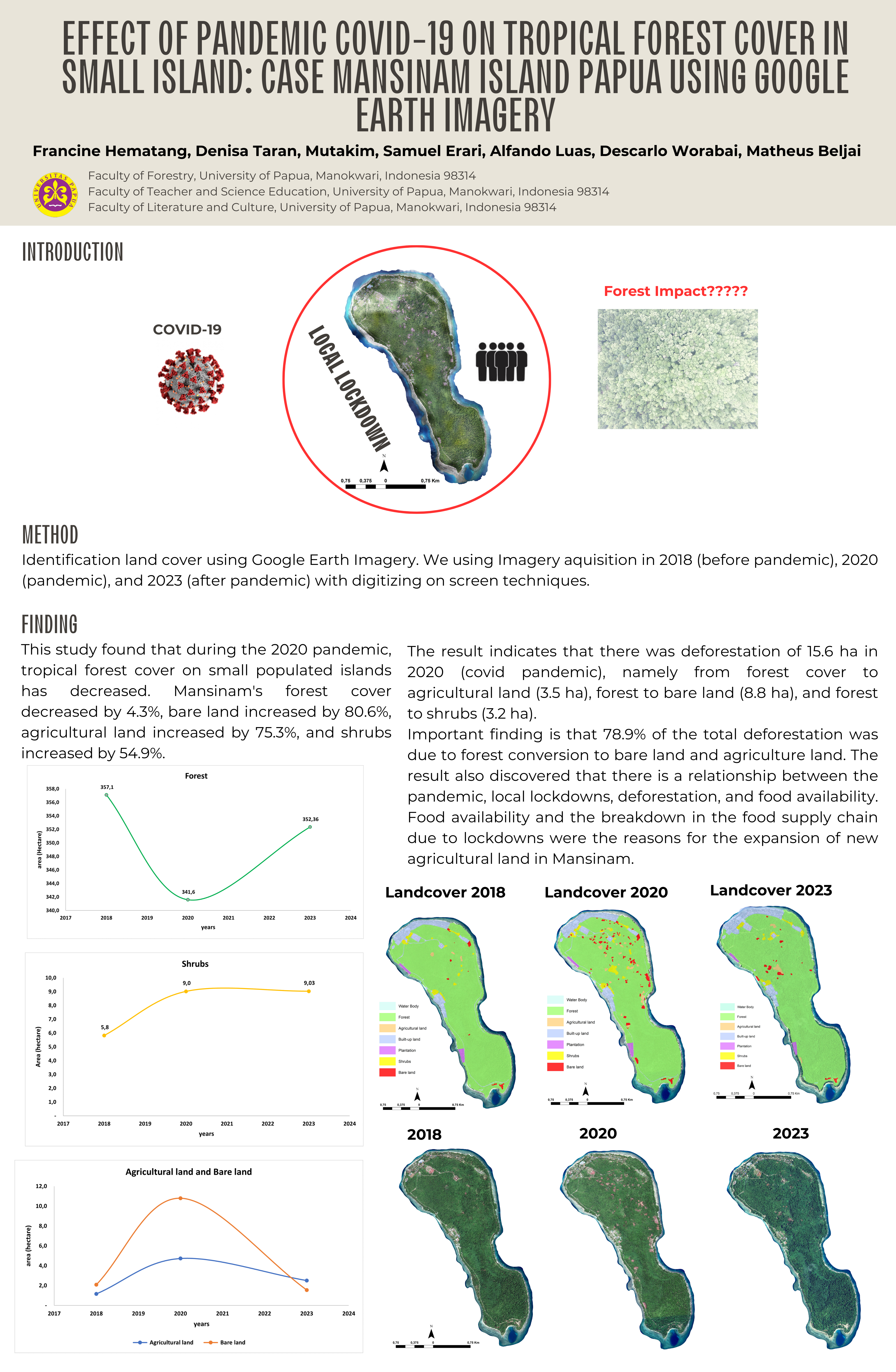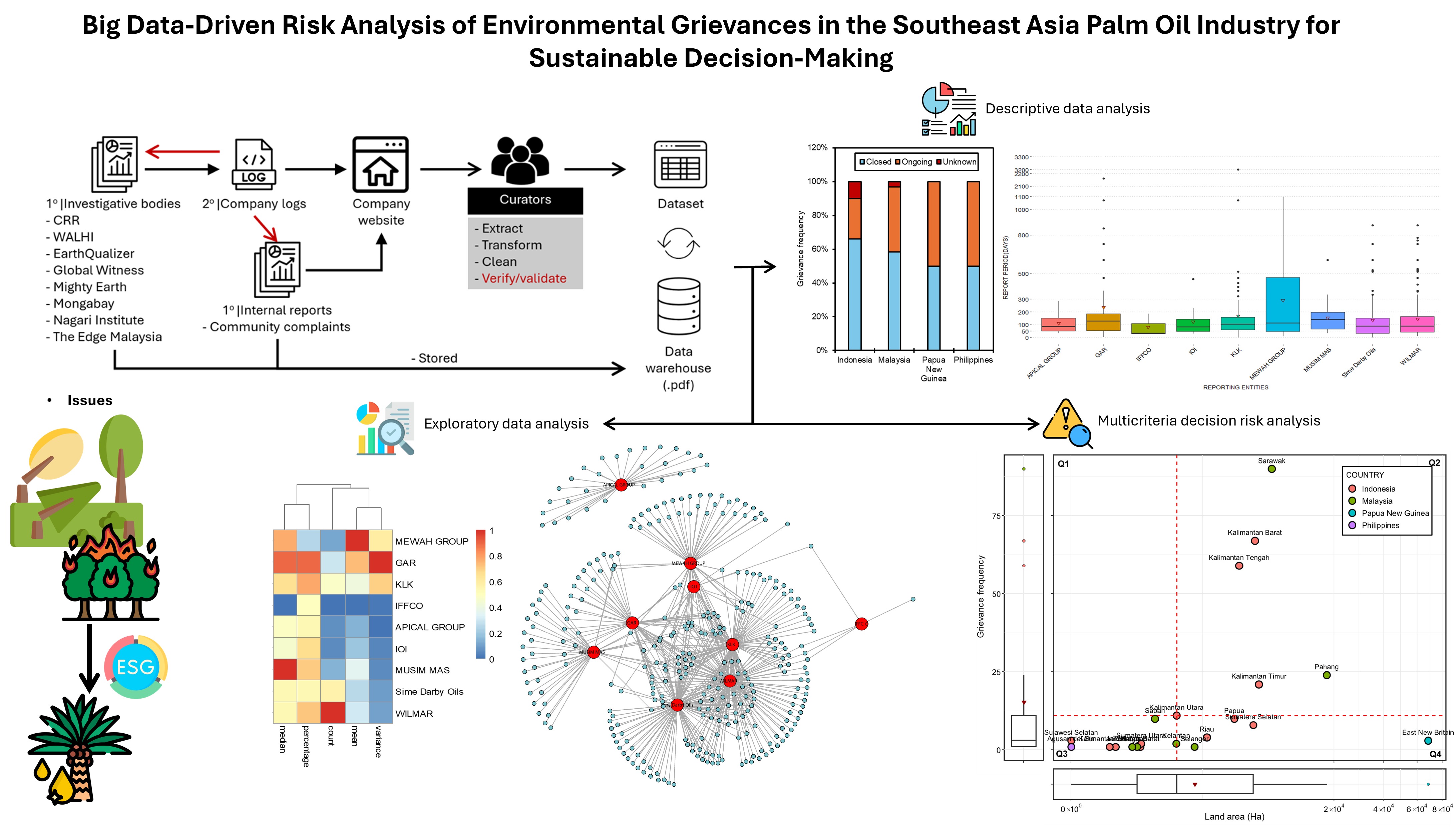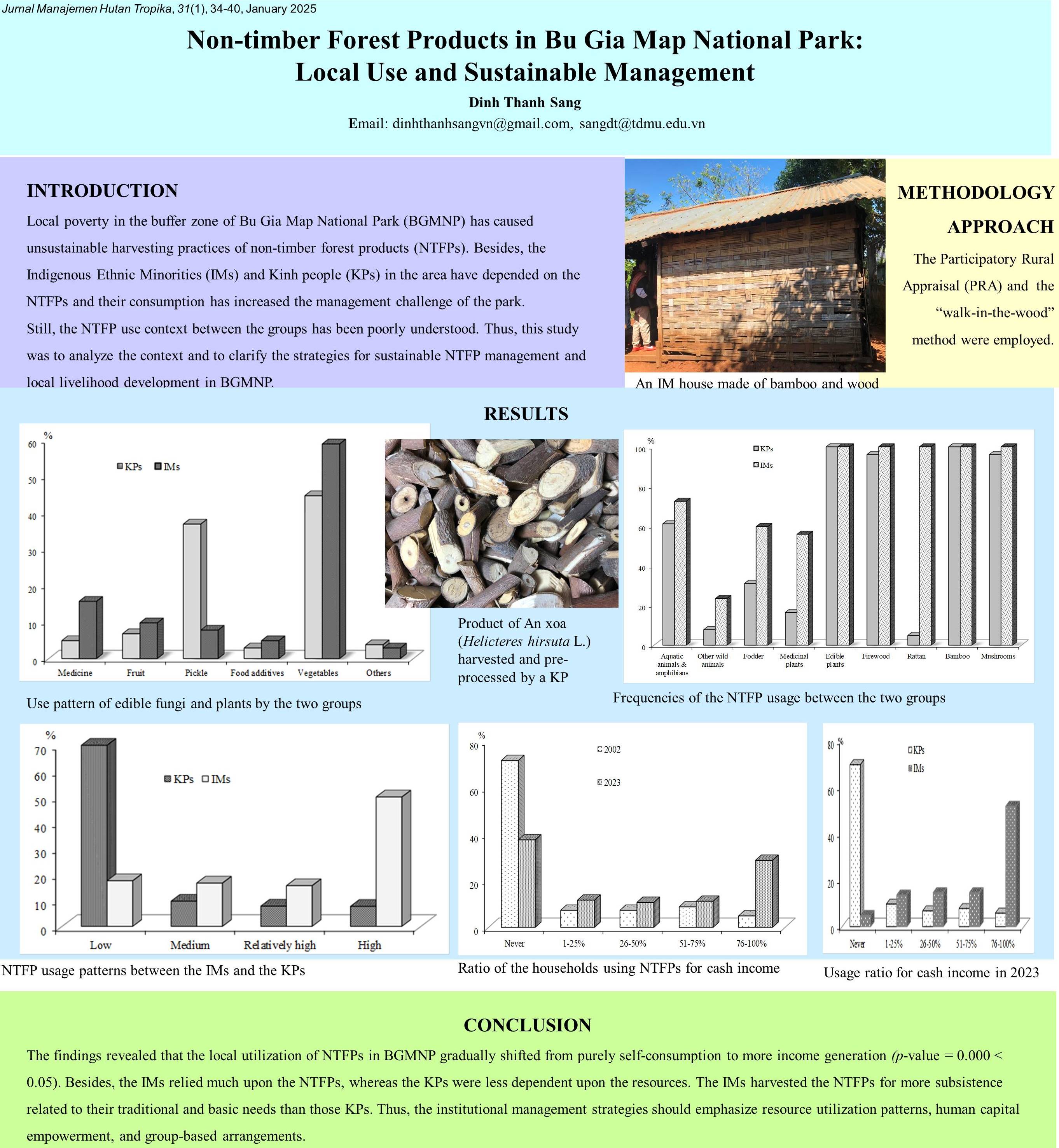Structure and Characteristics of Fuelwood Supply Chain in Yobe, Nigeria
Abstract
Fuelwood commercialization activities provide a source of livelihood in Nigeria. Despite its economic significance, the industry has been kept out of the formal economies due to a lack of supportive data on the structure and characteristics of the industry. This study investigates the structure of the supply chain and examines the chain actors' roles and functions to understand the issues within the supply chain activities. Data were collected through key informants' interviews and observations. The study found that fuelwood business activities were conducted formally by licensed actors and informally by non-licensed actors. Benefits received and issues experienced by actors were related to the formality of the business. Heavy reliance on natural forests for fuelwood production among chain actors can add pressure on the forest resources and ecosystem. Therefore, significant intervention is needed for the industry which includes policy and programs related to fuelwood plantation and management, government support, licensing education, and collaborations among all stakeholders to improve supply chain activities.
References
Adeyemi, A. A. & Ibe, A. E. (2014). Patterns of Firewood Exploitation and Utilization in Periurban and Rural Areas of Owerri Zone in Southern Nigeria. Nigerian. Journal of Agriculture, Food and Environment. 10(3), 113–119.
Alao, J. S., Ali, B., & Okrikata, E. (2016). Types of non-timber forest products in Yobe state, Nigeria. Gashua Journal of Irrigation and Desertification Studies. 2(1), 183–192.
Audu, E.B. (2013). Fuel Wood Consumption and Desertification in Nigeria. International Journal of Science and Technology, 3(1), 1–5.
Ali, B., Saadun, N., & Alias, M. A., & Kamarudin, N. (2019). Assessment of the fuelwood value chain in Yobe, Nigeria. In International Conference on Sustainable Energy and Green Technology 2018: IOP Conf. Series: Earth and Environmental Science 268 (2019) 012063 (pp. 1–8). Nigeria: IOP Conf. Ser.: Earth Environ. https://doi.org/doi:10.1088/1755-1315/268/1/012063
Bernard, H. R. (2000). Social research methods. Thousand Oaks, CA: Sage.
Cerutti, O. P. et al., (2015). The socioeconomic and environmental impacts of wood energy value chains in Sub-Saharan Africa: a systematic map protocol. Environmental Evidence, 4(12), 1–7.
FAO (2016a). FAOSTAT (dataset). Food and Agriculture Organization of the United Nations. Retrieved November 27, 2020, from http://faostat3.fao.org/faostat-gateway/go/%0Ato/browse/F/FO/E
FAO. (2016b). Yearbook of Forest Products: FAO Forestry Series No. 45. Food and Agriculture. Rome, Italy.
FAO (2020). Wood fuel Data. Retrieved from http://www.fao.org/faostat/en/#data/FO
Gbonegun, V. (2018). The need to protect forest. A paper presented at the Annual General Meeting (AGM,). Nigeria conservation foundation. Wildlife and conservation news: Guardian (November)
Green Energy (2018). Energy Policy.
http://www.greenenergyinvestment.com.ng/sites/default/files/documents/National%20Energy%20Policy.pdf
Guild, J., and C. M. Shackleton. "Informal urban fuelwood markets in South Africa in the context of socio-economic change. Energy Policy, 117 (2018): 136-141.
Ibrahim, A. A. (2012). MDGs and poverty in Yobe state. Ontario International Development Agency, 05(11), 119–132.
Jenkwe, E. D., & Iyeh, O. P. (2020). Assessment of fuelwood harvesting and its implication on vegetation loss in Ofu local government area, Kogi State, Nigeria. FUDMA Journal of Sciences, 4(2), 308-316.
Jepng'etich, K.S (2020). Sustainable Fuelwood Production In Kenya: Potential Role of Community Forest Associations. International Conference and Utility Exhibition on Energy, Environment and Climate Change (ICUE), 2020, pp. 1-6.
Larinde, S. L., & Aiyeloja, A. A (2015) Contribution of Mortar and Pestle Production to Rural Livelihood in Southwest Nigeria. New York Science Journal 8(4):1-7. http://www.sciencepub.net/newyork
Lelissa, T. B., & Kuhil, A. M. (2018). The Structure Conduct Performance Model and Competing Hypothesis- a Review of Literature. Research Journal of Finance and Accounting, 9(1), 76–89.
Liz G. & Weisse, M. (2019). Technical Blog: Global Forest Watch’s 2018. Data Update Explained. Retrieved from https://blog.globalforestwatch.org/data-and-research/technical-blog-global-forest-watchs-2018-data-update-explained
Miles, M.B., Huberman, A.M., & Saldana, J (2014). Qualitative Data Analysis: An Expanded Sourcebook. 3rd Eds. London: Sage.
MSG (1999). Community Engagement-Needs Assessment: Conducting Key Informant and Focus Group Interviews, Mountain State Group, Boise.
Naibbi, A. I. & Healey, R. G. (2013). Northern Nigeria’s Dependence on Fuelwood : Insights from Nationwide Cooking Fuel Distribution Data, 3(17), 160–173.
Naibbi, A. I. (2015). Traditional Energy Discourse : Situation Analysis of Urban Fuelwood Sourcing in Northern Nigeria. Resources and Environment, 5(6), 192–199.https://doi.org/10.4236/ijg.2014.51007
NBS (2017). Labor Force Statistics: Nigeria Unemployment and Underemployment Report. Abuja, Nigeria.
Ndiboi, S., & Dare, M. (2020). Final Draft Midterm Review (MTR) Report. MTR - UNDP/GEF-ECN: The Sustainable Fuelwood Management (SFM) Project in Nigeria (PIMS # 5366)
Nelson, I. U., Udo, E. S., & Jacob, D. E. (2017). Economic analysis of firewood marketing in Uyo capital city, Akwa-Ibom state, Nigeria, 5, 26–43.
Ojo, O. S. Okonkwo M. C., Oladele O. N., Jayeoba W. A., Suleiman R. A., & Yakubu, M. (2012). Evaluation of Wood Fuel Exploitation and its Relative Consumption Pattern in Kaduna Metropolis. Journal of Education and Social. Research, 2(7), 134 – 143(2012).
Onoja, A. O., & Emodi, A. I. (2012). Economic Analysis of Fuelwood Production and Consumption : Evidence from a Nigerian State. British Journal of Management & Economics, 2(1), 13–23.
Openshaw, K. (2011). Supply of Woody Biomass, Especially in the Tropics: Is Demand Outstripping Sustainable Supply? International Forestry Review, 13(4), 487-499.
Puentes-Rodriguez, Y., Torssonen, P., Ramcilovik-Suominen, S., & Pitkänen, S. (2017). Fuelwood value chain analysis in Cassou and Ouagadougou, Burkina Faso : From production to consumption. Energy for Sustainable Development, 41(July), 14–23. https://doi.org/10.1016/j.esd.2017.07.008
Purwestri, R. C., Hájek, M., Šodková, M., & Jarskỳ, V. (2020). How are wood and non-wood forest products utilized in the Czech Republic? A preliminary assessment of a nationwide survey on the bioeconomy. Sustainability (Switzerland), 12(2).
Sambe, L. N., Aondona, A. N., Adia, J. E., & Kwaghga, H. M. (2020). Assessment on forest offenses in North-central zone of Benue State, Nigeria. Journal of Research in Forestry, Wildlife and Environment, 12(4), 100-109.
Sola, P., Cerutti, P. O., Zhou, W., Gautier, D., Iiyama, M., Schure, J., & Shepherd, G. (2017). The environmental, socioeconomic, and health impacts of woodfuel value chains in Sub Saharan Africa : a systematic map. Environmental Evidence, 1–16. https://doi.org/10.1186/s13750-017-0082-2
Tan, N.Q. (2011). Chopping for chips: an analysis of wood flows from smallholder plantations in Vietnam. Working Paper 65. Center for International Forestry Research (CIFOR), Bogor, Indonesia.
Tanyi, T. F., Etongo, D., & Abdoulaye, R. (2018). Assessing the sustainability of fuelwood production and its potential impact on REDD+ in Burkina Faso. International Journal of Environmental Studies, 75(1), 186-200.
Tondoh J.D.A. (2015). Scoping study and prioritization of agroforestry species in pilot villages. Final report, executive summary. Burkina Faso
WFP, (2018). Rapid Livelihood Assessment in Damaturu, Jakusko and Bade Local Government Areas, Yobe State, Nigeria. Food security Analysis. 2018. Rome Italy., Nigeria. Retrieved from https://www.wfp.org/publications/nigeria-rapid-livelihood-assessment-damaturu-jakusko-and-bade-lgas-yobe-state-april-2018
World Bank. (2021). Universal access to sustainable energy report. Washington D.C. Retrieved from https://data.worldbank.org/en/news/press-release/2021/06/07/report-universa-access-to-sustainable-energy-remain-elusive-wiyhout-addressing-inequaities
WFP (2018). Rapid Livelihood Assessment in Damaturu, Jakusko and Bade Local Government Areas, Yobe State, Nigeria. Food security Analysis. 2018. Rome Italy., Nigeria. Retrieved from https://www.wfp.org/ publications/nigeria-rapid-livelihood-assessment-damaturu-jakusko-and-bade-lgas-yobe-state-april-2018
YSG (2019). Fuelwood and tree felling laws (Bos 1987).Yobe State of Nigeria Gazette. Notice. No. 62, 12(34). Government Printer Damaturu.
Zemba, A. A., Umar, Y., & Binbol, N. L. (2018). Climatic information as evidence of desertification processes in northern Yobe state, Nigeria: implications for agriculture and ecosystem. Global journal of pure and applied sciences. 24: 117-124. Global Journal of Pure and Applied Sciences, 24, 117–124.









